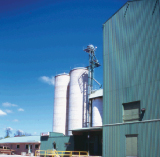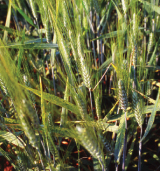
Features
Agronomy
Cereals
Durum: the new class of Ontario wheat
Processor’s needs pulled development of market
September 26, 2008 By Claire Cowan
Processor’s needs pulled development of market
Durum wheat, once thought to be strictly a western Canadian crop, has found its way to Ontario, and its arrival represents a win-win scenario for many in the agri-food sector.
In the past, most crops are introduced through the hard work and research of public or private sector breeders, then sales and promotions campaigns of seed companies and their representatives.
 |
| Howson & Howson of Blyth, Ont., was the primary in bringing durum wheat to Ontario. |
 |
| A pleasant surprise with the Hallmark durum variety is its adaptability and productivity to various growing conditions throughout Ontario. |
The process is often referred to as an industry “push,” and depending on the crop, some launches can seem as though the push is uphill.
In the case of durum’s arrival in Ontario, it has been a case of the downstream processor “pulling” the product through the value chain, as much a positive for C&M Seeds, the providers of Hallmark durum, as it is
for growers.
Howson and Howson, based in Blyth, Ont., is the miller that provided that industry pull, in much the same way that food manufacturers approached Monsanto to ask for help with the anti-trans fat movement in 2007. That pull resulted in Vistive soybeans’ vaulting to the scene late that year. Many in the Ontario wheat sector are hoping for a similar level of of success for everyone involved with Ontario-grown durum.
The long road to success
Although Hallmark from C&M Seeds is the only durum variety currently registered and available commercially in Ontario, Peter Johnson, cereal specialist with the Ontario Ministry of Agriculture, Food and Rural Affairs (OMAFRA) says other companies and land-grant universities in the U.S. are currently researching new durum varieties.
While Hallmark is the first durum variety to be registered, research on durum in Ontario is not new.
Researchers have been experimenting with durum in Ontario since the
mid 1980s.
But developing a variety suited to Ontario growing conditions was a slow, often disappointing task. “It was apparent that to be successful in durum was going to be a much bigger challenge than in other categories,” says John McLaughlin, coowner of C&M Seeds.
The development of a durum wheat variety was challenging because there is not a wide variety of durum genetics in the world. “Being very regional, there wasn’t the breeding investment throughout the world. There wasn’t a wide range of adaptability in durum genetics as there is in other wheat categories,” states McLaughlin.
The agronomic pros and cons
Agronomically, Hallmark is showing promise across Ontario. “We have growers this year from Chatham to New Liskeard and from Lake Huron to the Ottawa River,” says Barry Gordon, sales and marketing manager for C&M Seeds.
This wide growing area is surprising since durum is traditionally a regional crop grown only in dry areas However, C&M Seeds’ research indicates that Hallmark flourishes when it has access to water and does not yield well on gravelly, sandy, low moisture soils. This is promising news for producers on clay and clay loam soils.
Research also shows good standability as another of Hallmark’s beneficial characteristics. In addition, Johnson points out that durum wheat generally has a high falling number and strong sprouting resistance.
But when introducing a new variety, let alone a new class of wheat, hurdles must be expected. Johnson cites fusarium tolerance as one of the biggest challenges of growing durum wheat in Ontario.
According to OMAFRA’s 2008 Performance Trials for Spring Cereal Crops, Hallmark is rated as “highly susceptible” to fusarium. “Part of the problem is that where most of the variety development has been done, fusarium has not been a big issue.
So for spring wheats, it’s predominantly western Canada. And until the last few years, they didn’t really worry about fusarium,” explains Johnson.
Durum growers in Ontario are not unaware of the risk of fusarium in durum wheat. Steve Twynstra of Twilight Acre Farms Ltd. has been growing durum since 2005. Under dry conditions, he has only needed to spray fungicides for fusarium in 2006.
“There is an issue with fusarium. It is not very resistant at all, in fact, it is quite susceptible. I think we have the tools out there to manage that. It’s just a matter of management, like any other crop.”
Johnson adds, heat and humidity increase Ontario’s growing condition challenges compared to the growing conditions in western Canada. In order for durum to thrive in Ontario, it must have greater heat tolerance and be able to survive a totally different disease spectrum than western Canada, explains Johnson.
Fortunately, C&M Seeds’ experience with Hallmark during the past five years indicates the variety fares well in higher heat unit areas. However, the company hopes to learn more after the 2008 harvest, its initial big launch of acres.
Howson & Howson of Blyth, Ont, was the primary driver in bringing durum wheat to Ontario.
Good management practices are key
Five years of their own research and input from initial growers have gone into the creation of C&M Seeds’ best management fact sheet for Hallmark. Although C&M Seeds maintains that growing durum is very comparable to growing any hard red spring wheat, there are some specialized management practices required. For example, a timely harvest is critical for durum in order to maintain a glossy colour, which has been identified as an important trait for the end user.
Seeding rate also differs from other spring wheat varieties. Durum does not tiller as aggressively as traditional spring wheat and it has a slightly larger seed size. Therefore, growers should aim for 1.6 to 1.8 million seeds per acre.
Twynstra cites seeding rate as one of the challenges to growing durum. “The seeds are big. Two years ago, it was almost like planting rice. The big seeds didn’t flow through the air seeder very well and so we were not excited when we got our populations, we thought we were on the weak side. But at the end of the year, it still yielded well,” says Twynstra.
However, Twynstra does find many benefits to growing durum. “It provides another break up in the crop mix and diversification because it is a totally different marketplace,” he adds. It also allows him the ability to spread out the workload on the farm during the year a little better.
Twynstra thinks Ontario durum will become more significant in the future. But he also acknowledges the importance of quality and therefore the importance of segregation and proper management to maintain that quality. “I don’t think it is for every grower. I think for those that are looking for something different that can add to their bottom line in a meaningful way, there is tremendous opportunity there,” says Twynstra.
From Barry Gordon’s perspective, it is a higher value crop. “It requires slightly higher management skills to grow a good durum crop in Ontario from Hallmark than it does in a conventional hard red spring crop,” he continues. He also recognizes that the detailed management practices provided by C&M Seeds is part of the reason growers have made the decision to grow durum. These tried and tested practices help reduce the risk of growing something new.
Growers can also be confident in the market if they choose to grow durum. The relationship between C&M Seeds and Howson & Howson that has been forged since the late 1980s is based on the opportunities in the market for semolina flour, which is used to make pasta.
“It’s a symbiotic relationship. Howson’s has a market for the semolina flour but that isn’t possible without the production and seed research and the quality of the elevator and vice versa. It’s got to be all players with a common goal,” explains Gordon.
Opportunities in the market
Traditionally, durum is transported from western Canada to meet the needs of pasta producers in Ontario. But with the increasing costs associated with transporting goods across the country, it is easy to see the value in an Ontario produced durum.
Decreased transportation costs not only make financial sense, it is also an attractive option because of the increasing focus on the environment. Jeff Howson, vice president of Howson & Howson, sees Ontario durum as an environmentally friendly crop because of the reduction in food miles compared with a western Canadian durum crop.
Yet, in order for any type of market for Ontario durum to thrive, the semolina created from it must be of excellent quality. “We were actually shocked with the quality. It was far beyond what we anticipated. When we got into things, we anticipated Ontario durum being a durum you could bring in and put into your milling grind as a blend. But it’s been proven that we could put this durum on as a straight grind and make quality pasta,” explains Howson. Hallmark has proved itself in five years to be very comparable to western Canadian Amber durum.
A bright future for Ontario durum
The future of durum wheat in Ontario looks promising because the markets look promising. “The whole semolina industry is moving outwards. That creates more opportunity,” says Howson. Traditionally, semolina flour is used only for pasta. However, Howson & Howson is seeing semolina move beyond the pasta market and into the bakery industry, used to create specialty breads and buns.
On the production side, Gordon foresees durum providing growers with more options because of its adaptability. Durum wheat provides growers with another option if weather conditions are unfavourable for other major crops like corn, soybeans and winter wheat explains Gordon.
Howson agrees, adding that “it allows the Ontario farmer another opportunity; whether it be from a pricing stand point, a planting stand point or a harvesting standpoint.”
Although Ontario durum has a lot of potential its growth is still dependent on prices. Currently, Hallmark is a 95 yield index, while the best hard red spring wheat varieties are a 106 yield index. But the price incentives currently make up for that yield penalty. “It’s the price to yield ratio that will drive it,” says Johnson.
Johnson continues that “if it does well across environments and the price stays up, we could easily see 50,000 acres production, probably a lot more than that. We could ramp that up to a significant potential.”
From the C&M Seeds perspective, Hallmark grown under their specific management practices, yields will be competitive with the best red
spring wheats.
With all of this optimism, C&M Seeds and Howson & Howson’s agree that maintaining quality is imperative. Currently, Hallmark is being produced in a closed loop. Growers must sign a contract and market their wheat to be processed into semolina flour by Howson & Howson which is then marketed to Ontario pasta producers. Not only does this closed loop provide transparency for growers; they know exactly where their crop is going, it also provides the two companies the opportunity to maintain deliberate growth in order to maintain quality.
“As our commercial acres grow, we still want to maintain all of those superior qualities that we have done from stage one up to where we are now,” says Howson. But both Howson & Howson and C&M Seeds believe they are now in the position to see the market.